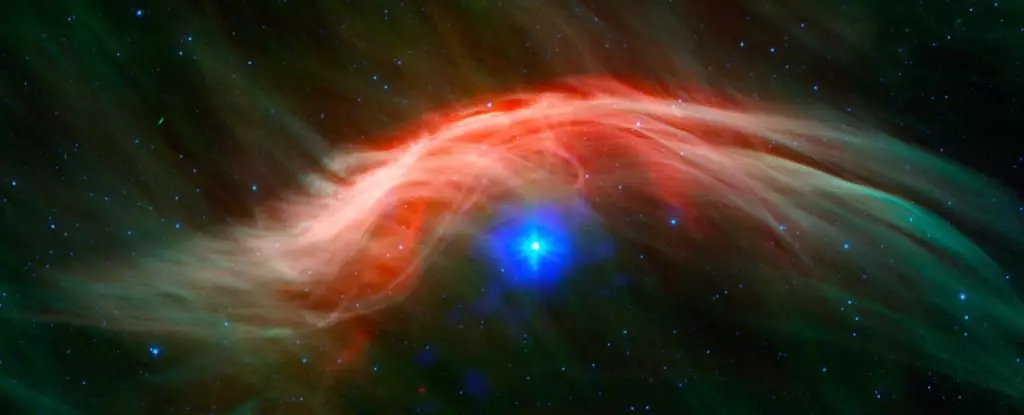The cosmos, with its enigmatic phenomena, holds secrets that could reshape our understanding of life on Earth. From the fiery birth of stars to the catastrophic explosions of supernovae, celestial events may exert profound influences on the evolutionary pathways of terrestrial species. A recent study highlights the potential link between a supernova explosion approximately 2.5 million years ago and a remarkable spike in viral diversity in one of Africa’s oldest and deepest lakes, Lake Tanganyika. This interplay between cosmic events and evolution raises intriguing questions about the interconnectedness of the universe and life on our planet.
Supernovae are among the most energetic events in the universe, marking the death of massive stars and the birth of new cosmic materials. When a star explodes, it releases a tremendous amount of energy and cosmic rays, which travel across vast distances. For Earth, situated in the Local Bubble—a relatively empty space within our galaxy—these cosmic rays could have far-reaching effects. According to researchers spearheaded by astrophysicist Caitlyn Nojiri from the University of California, Santa Cruz, the distance between a supernova and Earth does not diminish its potential impact on our biosphere.
Previous studies have established that our solar system exists within this Local Bubble, a region shaped by a series of supernova explosions millions of years ago. These explosions not only mark their violent endings but also serve as sources of materials vital for the formation of new celestial bodies and even life. The nuances of the relationship between supernovae and the Earth remain to be fully understood, but significant findings suggest that these cosmic occurrences could influence terrestrial evolution.
The research conducted by Nojiri and her team involved thorough examinations of deep-sea sediment samples that serve as a historical record of our planet’s environmental changes over millions of years. They specifically analyzed the presence of iron-60, a rare radioactive isotope formed in supernova explosions. By studying spikes in iron-60 found in ocean floor sediments, scientists could trace back significant cosmic events to distinct timeframes in Earth’s geological history.
Two pivotal spikes were identified: one occurring approximately 6.5-8.7 million years ago and the other between 1.5-3.2 million years prior. The latter spike is particularly relevant, as it aligns with a period when Earth was likely bombarded by cosmic rays from a nearby supernova. By simulating stellar movements, the researchers pinpointed potential culprits for this iron-60 influx to either the Scorpius-Centaurus group or the Tucana-Horologium group of stars.
The determination of which supernova might have driven the iron-60 spike provides a connection to its effects on Earth, showcasing a remarkable intersection of astrophysics and biology.
One of the most compelling aspects of this study is its potential implications for evolution on Earth. With the cosmic radiation levels soaring due to nearby supernovae, life forms could have experienced significant pressures leading to genetic mutations. The impact of radiation on life is complex; while radiation can induce detrimental mutations, it can also serve as a catalyst for diversification. Nojiri’s observations regarding the increase in viral diversity in Lake Tanganyika during the same time frame indicate that the fallout from cosmic events might have transformative effects on the microscopic world.
To add dimension to this hypothesis, it is essential to consider the findings from previous studies that identified a radiation threshold capable of causing DNA breaks, generally quantified at around 5 milligrays per year. The simulations conducted within Nojiri’s team suggested that cosmic doses significantly exceeded this threshold, lending weight to the notion that evolving organisms could have encountered new pressures during this time.
While the connection between a supernova and viral diversity remains correlative rather than causative, it invites us to reconsider our fundamental understanding of life on Earth. As Carl Sagan once philosophically asserted, we are made of stardust, emphasizing the intricate tapestry binding cosmic phenomena and terrestrial life. In recognizing that events in outer space have the capacity to influence life on our planet, we begin to appreciate the broader cosmic context of evolution.
The study spearheaded by Caitlyn Nojiri not only enhances our comprehension of Earth’s historical climate dynamics but also marks a step toward acknowledging the broader cosmic events that could influence life on our planet. There remains an expansive frontier to explore, suggesting that evolution is not merely a terrestrial affair but an intricately connected narrative spanning the cosmos. As we seek to unravel these profound connections, we may uncover a world where human existence is endlessly woven into the fabric of the universe.

